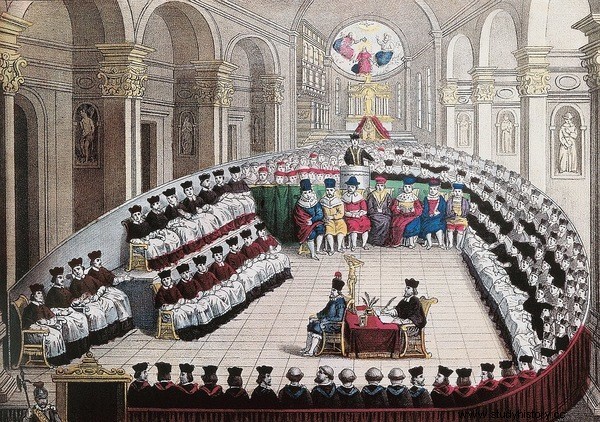- In the 15th th century, the wealth of the clergy often leads a corrupt life and contributes to the weakness of a Church which has not been able to reform itself. Among other things, the scandal of indulgences provoked in 1517 the beginning of a Protestant Reformation carried by Luther and which spread very quickly in Europe, leading from 1530 to religious wars led by Spain and France and to a great crisis. within the Church.
- Faced with this new threat, more present than the other heresies, the Church must reform itself in its doctrine as in its organization in order to retain spiritual power:it pulls itself together and launches for nearly a century the period of the Counter-Reformation (as opposed to Luther's Protestant Reformation), notably with the Council of Trent.
XVI th century

Characters
Luther
Paul III
Pie V
Procedure
After the Lutheran Reformation, Europe saw the appearance of new monastic orders, including the Jesuits, founded in 1540 by Ignatius of Loyola. Pope Paul III (1534-1549) initiates the reform by reorganizing the Inquisition and creating the Index of Prohibited Books; finally, he convenes the Council of Trent.
This council met several times during eighteen years, from 1545 to 1563, and took place under the pontificate of different popes; it allows the Church to ratify its dogmas which it unites in the Credo. Among other things, we find the cult of the saints and the Virgin denounced by the Protestants, but above all gives the Church the monopoly of the interpretation of the texts, the main criticism of Luther.
The council also reorganizes the structure of the Church, putting the clergy and the episcopate (the bishops) under closer control of Rome, in order to avoid abuses. Religious education seminars were also organized for priests, who were often uneducated at the time.
This reform of the Church was consolidated under the pontificate of Saint Pius V (1566-1572) who successfully attacked the corruption of Rome. The following popes kept the same logic, reforming the liturgy, consolidating the clergy and the episcopate, and guaranteeing a more enlightened education for clerics.
In the last quarter of the 16 th century, the Jesuit order enabled the Church to regain some of the ground lost in Germany and Eastern Europe.
Consequences
- The Church and the Catholic nations have reaffirmed themselves in Central Europe, but the divide is clear with Northern Europe.
- The consolidation of political conflicts around religious considerations leads to a reconfiguration of alliances.
